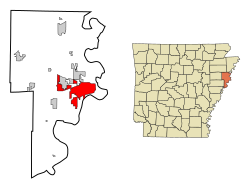West Memphis
| West Memphis, Arkansas | |||
|---|---|---|---|
| City | |||
 |
|||
|
|||
| Nickname(s): Wonder City, Gateway City | |||
| Motto: "Beautiful from every direction." | |||
 Location of West Memphis, Arkansas |
|||
| Location in the United States | |||
| Coordinates: 35°9′1″N 90°10′44″W / 35.15028°N 90.17889°WCoordinates: 35°9′1″N 90°10′44″W / 35.15028°N 90.17889°W | |||
| Country | United States | ||
| State | Arkansas | ||
| County | Crittenden | ||
| Incorporated | May 7, 1927 | ||
| Government | |||
| • Type | Mayor–council government | ||
| • Mayor | William H. Johnson | ||
| Area | |||
| • Total | 28.5 sq mi (73.9 km2) | ||
| • Land | 28.5 sq mi (73.7 km2) | ||
| • Water | 0.08 sq mi (0.2 km2) | ||
| Elevation | 210 ft (64 m) | ||
| Population (2010) | |||
| • Total | 26,245 | ||
| • Density | 923/sq mi (356.3/km2) | ||
| • Demonym | West Memphian | ||
| Time zone | Central (CST) (UTC-6) | ||
| • Summer (DST) | CDT (UTC-5) | ||
| ZIP codes | 72301, 72303 | ||
| Area code(s) | 870 | ||
| FIPS code | 05-74540 | ||
| GNIS feature ID | 0078727 | ||
| Website | www |
||
West Memphis is the largest city in Crittenden County, Arkansas, United States. The population was 26,245 at the 2010 census, ranking it as the state's 18th largest city, behind Bella Vista. It is part of the Memphis metropolitan area, and is located directly across the Mississippi River from Memphis.
Native Americans lived in the Mississippi River Valley for at least 10,000 years, although much of the evidence of their presence has been buried or destroyed. The Indians of the Mississippian Period were the last native inhabitants of the West Memphis area. Mound City Road, located within the eastern portion of the West Memphis city limits, has a marker indicating that the villages of Aquixo (Aquijo) or Pacaha were in the area. Several mounds are still visible.
Explorers from both Spain and France visited the area near West Memphis. Among those explorers were Hernando de Soto and his men from Spain and Father Jacques Marquette and Louis Jolliet from France. By the time French hunters and explorers entered the region, the Mississippian towns and other settlements had been abandoned. The original site of West Memphis came from Spanish land grants issued during the 1790s. Grants were given to Benjamin Fooy, John Henry Fooy, and Isaac Fooy in the Hopefield (Crittenden County) area and to William McKenney in the Bridgeport-West Memphis area.
In the summer of 1541, Spanish explorer Hernando De Soto crossed the Mississippi River into what is now Crittenden County with an army of over 300 conquistadors and almost as many captured Native American slaves. The Spanish found the land to be the most densely populated that they had seen since starting their journey on the Florida coast, two years earlier. The Spanish expedition departed Arkansas two years later, leaving behind numerous Old World diseases. It was 130 years before Europeans visited this region again. The French expedition of Joliet and Marquette in 1673 found none of the towns or people that the Spanish had documented; all that remained were the many mounds that still dot the landscape along the rivers and creeks. The original inhabitants, like the later settlers, were drawn to this region because of its fertile river bottom soil, abundant game, and thick forest.
...
Wikipedia



